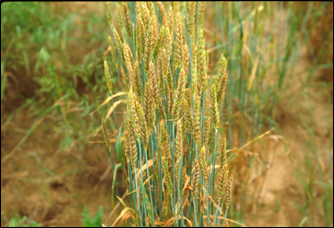Glume Blotch in Wheat
Glume Blotch
Symptoms

Stagonospora leaf and glume blotch
University of Kentucky Dept. Plant Pathology
Infected glumes develop gray-brown blotches usually starting at the tips of the glumes. Aged blotches develop dark pin-point structures called pycnidia (shown in the photograph below). Pycnidia are the source of infectious spores. Visible with a 10X lens, pycnidia on discolored glooms are the best sign of this disease. Infected heads develop low test weight due to shriveled grain.
Cause
Glume Blotch is transmitted by fungal spores of Stagonospora nodorum that blow or splash onto wheat heads. Spores usually originate from diseased foliage or infested wheat stubble. See the page on Leaf Blotch Complex for more information. Infections occur during periods of extended wetness.
IPM Techniques
- Plant moderately resistant varieties.
- Plant high-quality, well-cleaned, disease-free seed (e.g. certified seed).
- Avoid nitrogen excesses and deficiencies.
References and Additional Information
- IPM-4 Kentucky IPM Manual for Small Grains
- PPA-10c Kentucky Plan Disease Management Guide for Small Grains by D.E. Hershman and Paul Vincelli
- PPA-39 Septoria Diseases of Wheat by Donald E. Hershman
- PPA-36 Fungicides to Control Leaf Diseases in High Yield Wheat
- Foliar Fungicide Use in Wheat, Grain Gleanings, Vol.1, No. 3 (1993)
- Annual Kentucky Small Grain Variety Trials, Progress Report 355
- Selecting Wheat Varieties, Grain Gleanings, Vol. 1, No. 9 (1993)
- Common Diseases of Small Grain Cereals. F. J. International Maize and Wheat Improvement Center, Londres 40, Apdo. Postal 6-641, Mexico, D.F., Mexico
- Compendium of Wheat Diseases, M.V. Wiese, The American Phytopathological Society Press, 1987.


